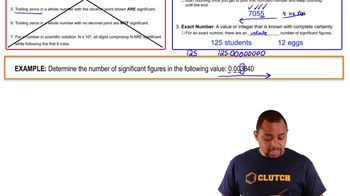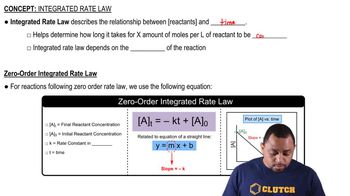Read each measurement to the correct number of significant figures. Laboratory glassware should always be read from the bottom of the meniscus. Digital balances normally display mass to the correct number of significant figures for that particular balance.
Ch.1 - Matter, Measurement & Problem Solving
Chapter 1, Problem 76
For each number, underline the zeroes that are significant and draw an x through the zeroes that are not. a. 180,701 mi b. 0.001040 m c. 0.005710 km d. 90,201 m
 Verified step by step guidance
Verified step by step guidance1
Identify the rules for significant figures: (1) All non-zero digits are significant. (2) Any zeros between significant digits are significant. (3) Leading zeros are not significant. (4) Trailing zeros in a decimal number are significant.
For 180,701 mi: Identify significant figures. The zeros between 8 and 7 are significant because they are between non-zero digits.
For 0.001040 m: Identify significant figures. The leading zeros are not significant. The zero between 1 and 4 is significant, and the trailing zero after 4 is significant because it is in a decimal number.
For 0.005710 km: Identify significant figures. The leading zeros are not significant. The zero after 1 is significant because it is between non-zero digits.
For 90,201 m: Identify significant figures. The zero between 9 and 2 is significant because it is between non-zero digits.

Verified video answer for a similar problem:
This video solution was recommended by our tutors as helpful for the problem above.
Video duration:
47sWas this helpful?
Key Concepts
Here are the essential concepts you must grasp in order to answer the question correctly.
Significant Figures
Significant figures are the digits in a number that contribute to its precision. This includes all non-zero digits, any zeros between significant digits, and trailing zeros in a decimal number. Understanding significant figures is crucial for accurately reporting measurements and calculations in chemistry.
Recommended video:
Guided course

Significant Figures Example
Leading Zeros
Leading zeros are the zeros that precede all non-zero digits in a number. They are not considered significant because they do not affect the value of the number. For example, in the number 0.001040, the leading zeros before the '1' are not significant, while the zeros after the '1' are significant.
Recommended video:
Guided course

Zero-Order Reactions
Trailing Zeros
Trailing zeros are the zeros that follow non-zero digits in a number. Their significance depends on the presence of a decimal point. In a decimal number, trailing zeros are significant, as they indicate precision, while in a whole number without a decimal, they may not be significant. For instance, in 180,701, all zeros are significant, but in 180700, the last two zeros may not be.
Recommended video:
Guided course

Zero-Order Reactions
Related Practice
Textbook Question
Textbook Question
Read each measurement to the correct number of significant figures. Laboratory glassware should always be read from the bottom of the meniscus. Digital balances normally display mass to the correct number of significant figures for that particular balance.
1
views
Textbook Question
For each number, underline the zeroes that are significant and draw an x through the zeroes that are not. a. 1,050,501 km b. 0.0020 m c. 0.000000000000002 s d. 0.001090 cm
1
views
Textbook Question
How many significant figures are in each number? a. 0.000312 m b. 312,000 s c. 3.12 × 105 km d. 13,127 s e. 2000
Textbook Question
How many significant figures are in each number? d. 1.563300×1011 m
1
views
1
rank
Textbook Question
How many significant figures are in each number? c. 108,700 km
